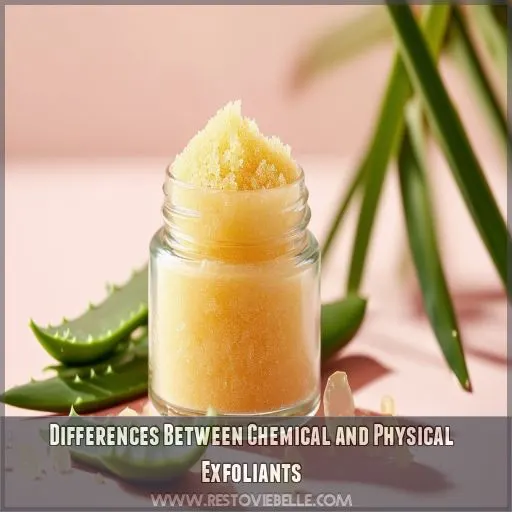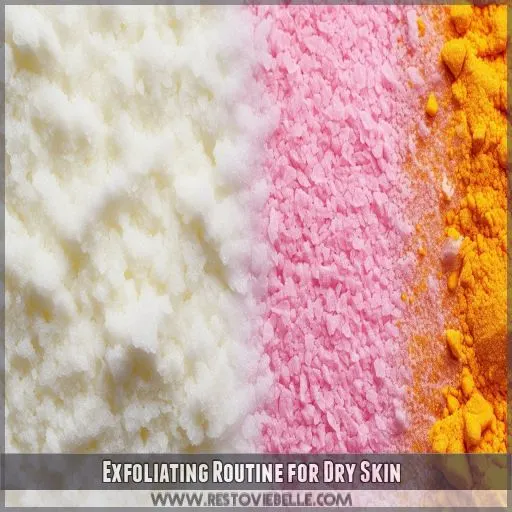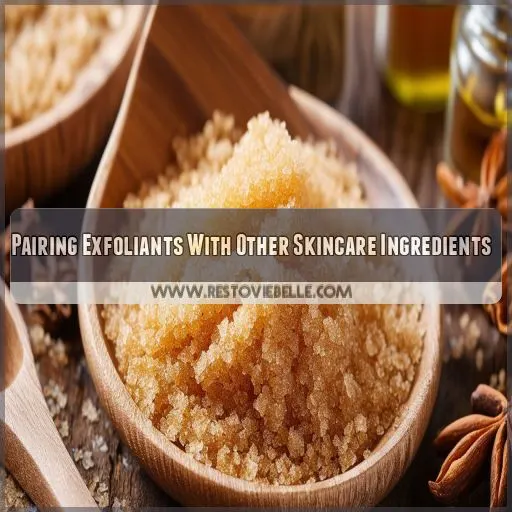This site is supported by our readers. We may earn a commission, at no cost to you, if you purchase through links.
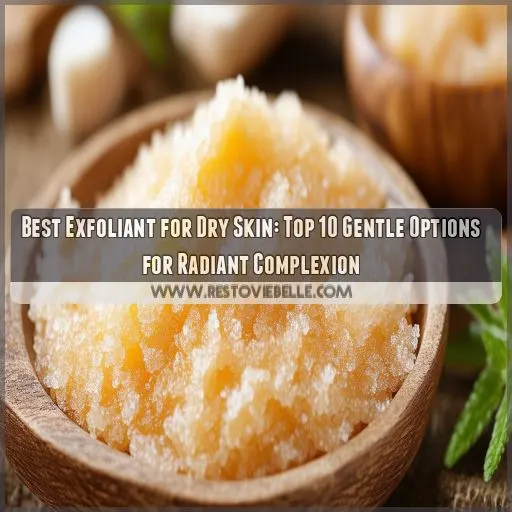
If you’re tired of flaky patches and dull complexion, you’re in the right place.
We’ve rounded up the top 10 gentle options to help you achieve that radiant glow.
From chemical peels to physical scrubs, we’ll explore the most effective exfoliants customized for dry skin.
You’ll learn how to choose the right product, how often to use it, and how to incorporate it into your skincare routine for best results.
Table Of Contents
- Key Takeaways
- Best Exfoliants for Dry Skin
- Differences Between Chemical and Physical Exfoliants
- Exfoliating Routine for Dry Skin
- Pairing Exfoliants With Other Skincare Ingredients
- Frequently Asked Questions (FAQs)
- What is the best exfoliator for dry skin?
- What is the best dry skin lotion?
- What kind of exfoliation is best for oily skin?
- What are the best exfoliating skincare products for clear skin?
- What’s the difference between chemical and physical exfoliants?
- Who should exfoliate?
- How often should you exfoliate your face?
- How often should you exfoliate your body?
- When should you exfoliate your face and body?
- Can you pair an exfoliant with other skin care ingredients?
- Is it possible to over-exfoliate?
- Which exfoliant is best for dry skin?
- What exfoliate do dermatologists recommend?
- What type of scrub is best for dry skin?
- Should you exfoliate if you have dry skin?
- Can exfoliating help with flaky patches on dry skin?
- How long does it take to see results from exfoliation?
- Are natural exfoliants effective for dry, sensitive skin?
- Should you exfoliate before or after cleansing?
- Can exfoliating worsen skin conditions like eczema or rosacea?
- Conclusion
Key Takeaways
- Ditch the sandpaper scrubs! Chemical exfoliants like Paula’s Choice 2% BHA Liquid are your dry skin’s new BFF, gently whisking away dead cells without turning you into a human snowglobe.
- Slow and steady wins the race: Start exfoliating just once a week, then gradually ramp up to 2-3 times if your skin is on board. Remember, you’re aiming for "glow," not "Stop, drop, and roll!"
- Timing is everything: Apply your exfoliant after cleansing but before moisturizing, like the opening act before the headliner. And stick to nighttime use – your skin doesn’t need to multitask while you’re dodging UV rays.
- Listen to your skin – it’s smarter than you think! If it starts throwing a tantrum (read: redness, flaking, or feeling tighter than your jeans after Thanksgiving dinner), ease up on the exfoliation ASAP.
Best Exfoliants for Dry Skin
You’ll find several effective exfoliants for dry skin, including Paula’s Choice 2% BHA Liquid Exfoliant, La Roche Posay Effaclar Clarifying Toner, and iS Clinical Cleansing Complex Polish. These products are designed to gently remove dead skin cells while maintaining your skin’s moisture balance, helping you achieve a smoother, more radiant complexion without causing irritation or dryness.
1. Paula’s Choice 2% BHA Liquid Exfoliant
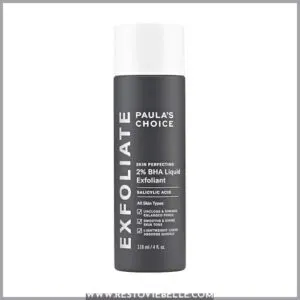
Paula’s Choice 2% BHA Liquid Exfoliant is a game-changer for dry skin.
This gentle, leave-on exfoliant harnesses the power of salicylic acid to unclog pores and smooth out wrinkles.
You’ll love how it brightens your complexion and evens out your skin tone.
It’s like a magic potion for combating redness and those pesky enlarged pores.
Don’t let the word "acid" scare you – it’s non-abrasive and suitable for all skin types.
Your skin will thank you!
Best For: Those with dry skin looking to combat redness and enlarged pores.
- Non-abrasive, leave-on exfoliant that is gentle on the skin
- Unclogs pores, smooths wrinkles, and brightens skin tone
- Suitable for all skin types
- May cause initial irritation
- Must use sunscreen while using this product
- Results may take time to appear
2. La Roche Posay Effaclar Clarifying Toner
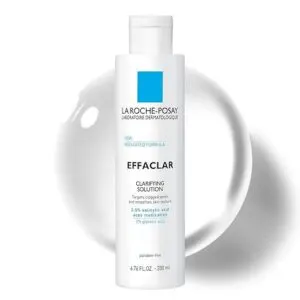
La Roche Posay’s Effaclar Clarifying Toner is a game-changer for dry skin.
It’s packed with salicylic and glycolic acids, working together to gently exfoliate and smooth your skin’s texture.
This powerhouse duo tackles everything from pesky blackheads to enlarged pores, leaving you with a clearer complexion.
Don’t worry about irritation – it’s fragrance-free and perfect for sensitive skin.
You’ll love how fresh your face feels after use.
Just remember, even with dry skin, moderation is key.
Start slow and watch your skin transform!
Best For: Dry skin types looking to reduce the appearance of blackheads and enlarged pores.
- Exfoliates and smooths skin texture
- Reduces the appearance of blackheads and enlarged pores
- Fragrance-free and suitable for sensitive skin
- May cause irritation in some skin types
- Not recommended for use on broken skin
- May cause dryness if overused
3. iS Clinical Cleansing Complex Polish
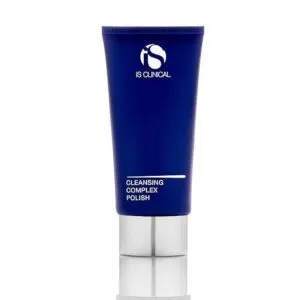
You’ll love the iS Clinical Cleansing Complex Polish for its gentle yet effective exfoliation.
This powerhouse cleanser deep-cleanses and smooths rough texture without irritating your dry skin.
It’s packed with exfoliating granules that tackle makeup and unclog pores, leaving your face feeling soft and refreshed.
A little goes a long way, so you’ll get plenty of use from one tube.
While some users find the granules a bit plastic-like, most rave about the results.
Just remember to start slow – it might be too intense for daily use if you’ve got sensitive skin.
Best For: Those looking for a gentle yet effective exfoliating cleanser that deep-cleanses and smooths rough texture without irritation.
- Deep-cleanses and gently exfoliates without irritation
- Smooths rough texture
- Refines the appearance of pores
- Granules feel like little pieces of plastic to some users
- May be too harsh for daily use for some users
- Not a strong scent
Differences Between Chemical and Physical Exfoliants
Chemical exfoliants use acids to dissolve dead skin cells, while physical exfoliants rely on particles or textured materials to manually remove them. Understanding these differences can help you choose the right exfoliant for your dry skin, as chemical options are often gentler and more effective for this skin type.
How Chemical Exfoliants Work
Chemical exfoliants work by penetrating your skin’s surface, dissolving the bonds between dead skin cells.
These powerful ingredients, like AHAs and BHAs, enhance product absorption and stimulate cell turnover.
They’re particularly effective for dry skin, as they gently exfoliate without harsh scrubbing.
By promoting skin renewal, chemical exfoliants can help reduce acne, mitigate wrinkles, and reveal a brighter complexion.
They’re a game-changer for achieving that coveted healthy glow.
How Physical Exfoliants Work
While chemical exfoliants dissolve dead skin cells, physical exfoliants work by manually scrubbing them away.
These abrasive products come in various forms, from natural scrubs to synthetic powders.
You’ll find both store-bought and DIY options, each with its own pros and cons.
Physical exfoliators can be gentler on dry skin when used correctly, but it’s essential to choose non-abrasive formulas to avoid irritation.
Exfoliating Routine for Dry Skin
You’ll want to establish a gentle exfoliating routine for your dry skin, focusing on the right frequency and product selection. Start by exfoliating once a week and gradually increase to 2-3 times weekly if your skin tolerates it well, while keeping an eye out for signs of overexfoliation like redness or flaking.
Frequency of Exfoliation
Regarding exfoliating dry skin, moderation is key.
Begin with weekly exfoliations and gradually increase to twice weekly if your skin tolerates it well.
Observe your skin’s sensitivity and dryness levels. Excessive exfoliation can damage your skin barrier, so proceed cautiously.
The frequency also depends on the ingredients in your exfoliant. For instance, milder lactic acid (L) or PHAs may be used more frequently than potent glycolic acid (G).
Choosing the Right Exfoliator
When choosing an exfoliator for dry skin, opt for gentle chemical exfoliators with ingredients like lactic acid or glycolic acid.
These offer numerous benefits, including improved hydration and skin texture.
For physical exfoliators, use sparingly, no more than once a week.
Tailor your dry skin exfoliation routine to your skin’s needs, starting with less frequent applications and gradually increasing as tolerated.
Signs of Overexfoliation
Watch out for these telltale signs of overexfoliation: redness, irritation, and inflammation.
Your skin might feel tight, flaky, or even start peeling.
If you’re seeing these symptoms, ease up on your exfoliant use.
Stick to gentle exfoliants and a less frequent routine to maintain that radiant complexion you’re after.
Your skin’s natural barrier will thank you!
Pairing Exfoliants With Other Skincare Ingredients
When incorporating exfoliants into your skincare routine, timing is essential for effective results. Apply chemical exfoliants after cleansing but before moisturizing, allowing them to work directly on your skin without barriers, and use them in the evening to avoid potential sun sensitivity during the day.
When to Apply Exfoliants
Now that you’ve established your exfoliating routine, let’s talk about when to apply exfoliants.
For dry skin, it’s best to exfoliate at night, giving your skin time to recover.
Apply your exfoliant after cleansing but before serums and moisturizers.
Be cautious when layering products, as some ingredients may not play well together.
Frequently Asked Questions (FAQs)
What is the best exfoliator for dry skin?
For dry skin, you’ll want a gentle chemical exfoliant like lactic acid or PHAs. Look for products with hydrating ingredients too. Try SkinCeuticals Micro-Exfoliating Scrub or Tatcha The Rice Polish for a smooth, radiant complexion.
What is the best dry skin lotion?
You’ll feel like you’re floating on a cloud with CeraVe Moisturizing Cream. It’s packed with ceramides and hyaluronic acid, delivering intense hydration without feeling greasy. Apply it daily to keep your skin soft, supple, and deeply nourished.
What kind of exfoliation is best for oily skin?
For oily skin, chemical exfoliants like AHAs and BHAs work best. They’ll unclog pores, control excess oil, and reduce acne. Use salicylic acid (BHA) twice weekly, and glycolic acid (AHA) once a week for ideal results.
What are the best exfoliating skincare products for clear skin?
Like a gentle breeze on a summer day, the right exfoliant can sweep away impurities. For clear skin, you’ll want to try glycolic acid toners, salicylic acid cleansers, or enzyme masks. These powerhouses effectively unclog pores and reveal radiant skin.
What’s the difference between chemical and physical exfoliants?
Chemical exfoliants use acids to dissolve dead skin cells, while physical exfoliants scrub them away with particles. You’ll find chemical exfoliants gentler and more effective, especially for sensitive skin. They’re like invisible workers, quietly revealing your glow.
Who should exfoliate?
If you’re feeling like you’re in a rut, exfoliating can be a game-changer. Most adults can benefit from it, especially those with dull skin, clogged pores, or uneven texture. Start slow and listen to your skin’s needs.
How often should you exfoliate your face?
You should exfoliate your face 1-3 times a week, depending on your skin type and the product you’re using. Start with once weekly and gradually increase if needed. Don’t overdo it, as that can irritate your skin.
How often should you exfoliate your body?
You should exfoliate your body 1-2 times a week. If you’ve got sensitive skin, stick to once weekly. For tougher areas like elbows and feet, you can exfoliate up to 3 times weekly. Listen to your skin’s needs.
When should you exfoliate your face and body?
Like a gentle wave washing over sand, exfoliate your face 1-3 times weekly, depending on skin sensitivity. For your body, aim for 2-3 times weekly. Always exfoliate after cleansing but before moisturizing for best results.
Can you pair an exfoliant with other skin care ingredients?
You can pair exfoliants with other skincare ingredients, but be cautious. Combine them with hydrating products like hyaluronic acid or ceramides. Avoid using retinoids or vitamin C simultaneously, as this may cause irritation. Always follow with sunscreen during daytime use.
Is it possible to over-exfoliate?
You’re scrubbing away, feeling refreshed, when suddenly your skin feels tight and irritated. Yes, over-exfoliation is possible. It’s like overdoing a good thing – your skin can become sensitive, red, and flaky. Moderation is key.
Which exfoliant is best for dry skin?
For dry skin, opt for gentle chemical exfoliants like lactic acid or PHAs. You’ll want to choose products that exfoliate while hydrating, such as the SkinCeuticals Micro-Exfoliating Scrub or Tatcha The Rice Polish. Always follow up with a moisturizer.
What exfoliate do dermatologists recommend?
Dermatologists often recommend chemical exfoliants like AHAs and BHAs for their effectiveness and gentleness. You’ll find glycolic acid, lactic acid, and salicylic acid in many top-rated products. Always start with lower concentrations and gradually increase to avoid irritation.
What type of scrub is best for dry skin?
For your parched skin, opt for a gentle, creamy scrub with hydrating ingredients. You’ll want to avoid harsh, abrasive particles. Look for scrubs with jojoba beads or rice powder, which exfoliate without stripping moisture.
Should you exfoliate if you have dry skin?
Yes, you should exfoliate dry skin, but gently. It’ll remove dead cells, improve texture, and help moisturizers penetrate better. Use a mild chemical exfoliant or enzyme-based product 1-2 times weekly, followed by a rich moisturizer.
Can exfoliating help with flaky patches on dry skin?
While flaky patches can be frustrating, exfoliating can be a double-edged sword for dry skin. It’ll remove dead cells, revealing smoother skin, but it might also irritate. You’ll want to exfoliate gently and moisturize immediately after.
How long does it take to see results from exfoliation?
You’ll typically see initial results from exfoliation within a week or two. However, for significant improvements in skin texture and tone, it’s best to stick with a consistent routine for at least 4-6 weeks.
Are natural exfoliants effective for dry, sensitive skin?
You might think harsh scrubs are best, but gentle’s the way to go. Natural exfoliants like oatmeal or honey can work wonders for dry, sensitive skin. They’ll slough off dead cells without stripping your skin’s natural oils.
Should you exfoliate before or after cleansing?
You should cleanse before exfoliating. This removes surface dirt and oils, allowing the exfoliant to work more effectively on your skin. After exfoliating, rinse thoroughly and apply moisturizer to lock in hydration and soothe your freshly exfoliated skin.
Can exfoliating worsen skin conditions like eczema or rosacea?
Yes, exfoliating can worsen eczema and rosacea. These conditions make your skin more sensitive, so harsh scrubs or acids can irritate it further. You’ll want to be extra gentle and consult a dermatologist before trying any exfoliation.
Conclusion
Imagine a world where dry, flaky skin is obsolete.
By selecting the optimal exfoliant for dry skin, you’re taking a pivotal step in that direction.
Begin with mild products, exfoliate 1-2 times weekly, and always apply moisturizer afterward.
Monitor your skin’s reaction and adjust accordingly.
With the correct approach, you’ll achieve the radiant, smooth complexion you’ve long desired.

